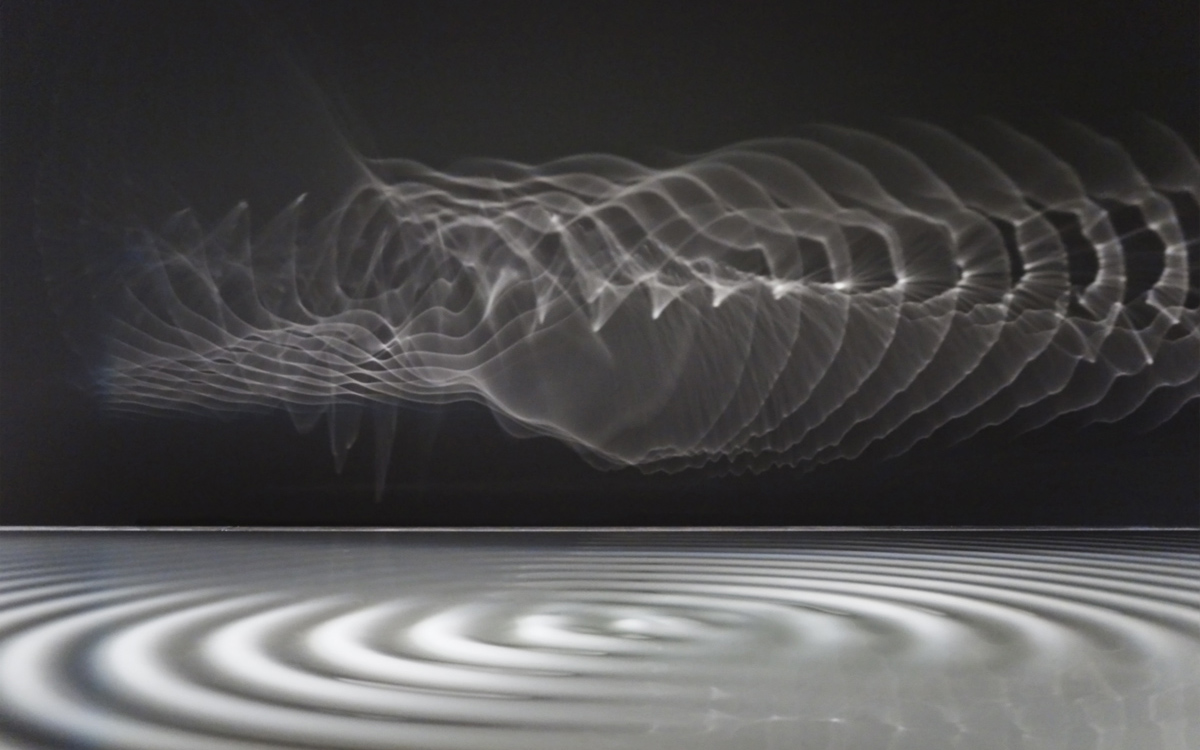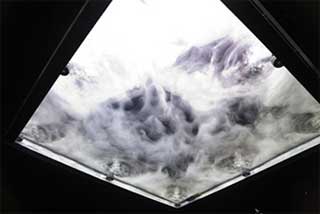Shawn Alan Brixey, Aqua Echo, 1987
(…) “Above the performance site a large 8′ x 10′ aluminum framed water filled ripple-tank floats 10′ above the floor. Two 500W point source lights with barn-doors placed next to each other, and fixed 16′ from the ground project bright light through the surface of the water hovering above the dancers and audience. Each point source is fitted with circular polarizers that project polarized light through the water. The surface of the water is hypersensitive to movement in the installation space as the ripple tank is cabled to a sprung wood floor allowing the tiniest vibration to undulate the surface of the water by both dancers and audience movement. The floor, painted with non-depolarizing paint has stereo 3D pair images of the ripples projected on the floor as well as on to the bodies of the dancers and audience. Audience members wear 3D glasses creating a stereo 3D image of the ripples, and the sensation of being immersed in water”.
(…) “Sobre el sitio de la performance un largo marco de aluminio de 8´ por 1o´ llenado de agua como ripple-tank flota sobre 10´del suelo. Dos puntos de luz de 500W con barn-doors puestas cerca una de otra, y ajustados a 16´desde el suelo proyectaban brillante luz a través de la superficie del agua flotando encima de los bailarines y la audiencia. Cada punto de luz es ajustado con polarizadores circulares que proyectan luz polarizada a través del agua. La superficie del agua es hipersensible al movimiento en el espacio de la instalación ya que el ripple-tank es cableado al suelo de madera por una cuerda elástica metálica permitiendo que la más ligera vibración por los bailarines o la audiencia ondulara en la superficie del agua. El suelo, pintado con pintura no despolarizante, tiene pares de imágenes 3d de las ondas proyectadas en el suelo, asi como en los cuerpos de los bailarines y la audiencia. La audiencia usa lentes 3d creando una imagen 3d de las ondas, y la sensación es la de estar inmerso en el agua”
“Describe for us the installation you set up in the Ásmundur Sveinsson Sculpture Museum
That work is called “Sphere 2003” and it is now owned by an Austrian collector. I began by measuring the frequency of the space or sphere, which turned out to be about 55 Hz, and decided to work with the frequencies around it, i.e. 50-60 Hz. In the middle of the space (focus) I put a bowl containing about one litre of water on a column. The halogen lamp inside the column shone through the bowl and threw the circular surface of the water onto the dome of the sphere. The waves on the surface are continually changing according to the blend of frequencies that hit them. I am working with medium-wave wave interference, which means that if I have, for instance, a 50 Hz tone and I play a 53 Hz tone beside it, getting a 3 Hz halftone which in reality is the third tone, resulting from the other two”. Acoustic image of the present Interview with Finnbogi Pétursson for the magazine Kunst und Kirche (Art and Church) 2/2006 – Gunnar Kristjánsson
“Ondulation is a composition for water, sound and light. It employs a two ton pool of water which is set into motion using sound. Beams of light are projected onto the surface of the water and reflect onto a projection screen. The pool becomes a “liquid mirror” that is slowly sculpted into perfect three-dimensional expressions of a musical composition. In turn, the light on the screen is modulated by the movement of the water into complex visual forms which maintain perfect congruity with their musical source. The resulting fusion of sensory experiences is a temporal sculpture: a construction of water, sound and light which evolves as a composition in time”.
“Presented as a “temporal sculpture,” Ondulation (2002), a composition for water, sound and light, was created by Thomas McIntosh in collaboration with composer and friend Emmanuel Madan (the pair go by the pseudonym [The User]), and Mikko Hynnimen, a sound designer, lighting specialist, scenic artist and composer based in Helsinki, Finland. The installation is an extension of finale (2001), the final work created in the Silophone project. During finale, various solids, liquids and gases were placed into large loudspeakers and set into motion by audio signals produced with a computer. McIntosh and Madan thus established a direct relationship between the surface of the water placed in the speaker and the sounds emitted. Waves of sound were translated into waves of water. Likewise, changes in sound intensity and the addition of other frequencies created corresponding alterations in the water’s surface. McIntosh and his collaborators have continued the exploration launched in finale by pursuing their interest in synesthesia, where a visual sensation is experienced through its analogy with an auditory perception – which describes precisely the Ondulation experience. In fact, the simultaneity is such between the sound and light waves – the sound vibration is identical to the image’s rhythm reflected on the walls – that we are left with a sense of seeing the sound and hearing the image. The correlation between the elements leaves spectators musing over the cause and effect of that which is right before their eyes. Paradoxically, while the work is inevitably subject to the element of duration, the notion of time is lost, carried away by the rippling water and the arabesques of light on the walls. With Ondulation, McIntosh offers an experience that moves beyond aesthetics to establish itself in the real world and not merely in one imagined or symbolic” Thomas McIntosh, Ondulation, Jacques Perron

Ryuichi Sakamoto + Shiro Takatani, LIFE – fluid, invisible, inaudible … (2007)
“In this work, YCAM’s studio A, which is usually used as a theater space, is arranged as a huge flat exhibition space, in which sound and image are suspended so that the artists can attempt to express the fusion of both sound installation and image installation treated equally in the entire space. The installation consists of nine acrylic water tanks 1200mm square x 300mm high. The nine tanks are placed to form a 3 x 3 grid, hung in space at 2.4m from the ground. Each water tank is put between speakers, which are also suspended in the air. Mist is artificially made by ultrasonic waves inside each tank, and the condition and flow of the mist can be controlled. These nine blocks of mist serve as a screen for images that are projected from the ceiling downward. How the images are visible and reflected depends on the condition of the mist. Different or same contents are projected on the nine mist screens, sometimes working in conjunction and at other times working individually. The images and sound may or may not be synchronized, and sound is sometimes audible without images. Basically everything is controlled, although the whole content might drastically change, if triggered by some factor in the exhibition space when detected by sensors. The contents of the images and the sound are digitized by computers, and are processed and worked on in great detail. There is no fixed way in which the work can be appreciated. Visitors can feel, while walking freely around the installation space, how the relations between the environment and perception (hearing and sight) are expressed in a complex but fluid way. The work is designed to show the visitors the relationship between perception and the environment as an artistic space of sound and image, and the possibilities between the two”





